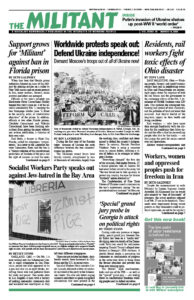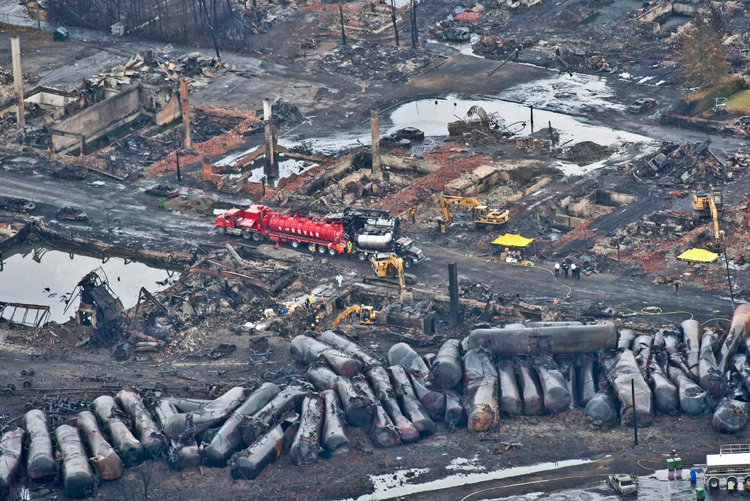EAST PALESTINE, Ohio — Working people, farmers and small-business owners here and in neighboring towns in Ohio and Pennsylvania are increasingly angry about the response of both the rail bosses and the government to the continuing effects of the Feb. 3 derailment of Norfolk Southern train 32N here. This includes the subsequent fire, burning and spread of toxic chemicals, and the pollution of land and water that occurred. And they’re fearful of the long-term impact on their health and living conditions.
Rail workers — who have more than enough familiarity with the disdain for the conditions they labor under and the effects that has on working people who live by the tracks — are discussing the need for union control over rail operations.
Militant worker-correspondents met Tish McDevitt, who lives in Negley, just south of East Palestine, Feb. 25. She was told to evacuate when the railroad was going to drain and burn toxic vinyl chloride from derailed tank cars that threatened to explode. “But now we’re told we’re not eligible for any aid for the evacuation or the aftermath of the fire,” she said. Leslie Run Creek, which carried spilled chemicals down to the Ohio River, runs through Negley. “And we are worried sick about the safety of our well water. Maybe it tests ‘safe’ today. What about after the chemicals have time to seep into the ground?”
Diana Elzer, a co-owner of Sutherin greenhouse where McDevitt works, said, “No one blames the crew of that train. It was the greed of the company that caused it. Why couldn’t the company say what the train was carrying? It was days before the Environmental Protection Agency released the information on the other chemicals that were spilled.”
In fact, the first responders on the scene after the derailment and fire broke out — who weren’t issued hazmat suits or respirators to protect themselves — knew nothing about what was burning or being released into the air. Days later it became clear that hazardous chemical placards on dangerous tank cars melted in the fire.
Elzer has issues with the cleanup the railroad is doing. “Norfolk Southern’s CEO, Alan Shaw, admitted the company had no intention of removing the soil containing the chemicals that are under the tracks,” she said. “After their burn of those deadly chemicals, they had those tracks in and the trains were running in no time.”
When people complained enough, and the press reported it, “19 days after the disaster, Shaw said, ‘I listened to community members’ and will remove the contaminated soil,” Elzer said. When Norfolk Southern and government officials announced they planned to drain and set fire to the toxic vinyl chloride, Linda Murphy, who lives on the south end of East Palestine, told us, “I sped home, put the horse in the trailer, gathered our dogs and fled.
“When we came back my horse’s face, neck and chest swelled up. He was lethargic. The vet explained that it was caused by an allergic reaction to an ‘environmental issue.’ Guess what that was?
“The Leslie Run Creek right below our house is full of dead fish and frogs.”
The Ohio Department of Natural Resources has upped its estimate for the number of fish and other animals killed near East Palestine from 3,500 to 44,000.
Murphy said the clinic the Ohio Department of Health opened in East Palestine is a joke. “Since the burn, I’ve had headaches, my eyes hurt, my throat is killing me. Outside, I have a hard time breathing. So, on the first day it opened, I took a day off work and went. There was no doctor there. The nurse took my information and referred me to my own doctor with a ‘sinus infection.’”
Rail crew gets alert too late
The National Transportation Safety Board issued a preliminary report on the derailment Feb. 23. It said the train crew only got warning of an overheated wheel from a wayside detector seconds before it derailed.
Norfolk Southern, like other rail bosses, says one of the reasons it has slashed workers — helping boost profits — is they’ve been replaced by better technology. This includes the wayside detectors. As train 32N neared East Palestine, three detectors began registering soaring wheel temperatures on car 23, hitting 103 degrees higher than the air temperature at milepost 69.01, where security camera footage at a trackside factory showed sparks flying from the wheel. This wasn’t enough to trip an alert to the crew.
As the train got to East Palestine, the temperature on the wheel had reached a whopping 253 degrees higher than the air, and the crew finally got an alert, way too late to prevent the derailment.
National Transportation Safety Board Chairwoman Jennifer Homendy admitted to the press that while the detector alert “system” worked just as it should have, still the derailment and ensuing crisis “was 100% preventable.”
Reminder of Lac-Megantic disaster
What has unfolded in East Palestine reminds many rail workers of the 2013 calamity that befell the people of Lac-Megantic in Quebec. The brakes on a parked train carrying oil tankers on a hill outside the town bled out and it rolled into the town’s center and derailed, exploding and bursting into flame. Forty-seven people were killed.
When government officials and the rail bosses tried to pin the blame on rail workers, they were exonerated. It was the bosses, with their one-man crews and 12-hour shifts, who were responsible.
The Coalition of Citizens and Organization Committed to Rail Safety has fought to have the new railroad’s tracks moved outside the city center. When members of the Communist League visited Feb. 25 and discussed what was unfolding in East Palestine, committee leader Robert Bellefleur said they knew of it and had sent a statement of solidarity.
“Our Coalition of Lac-Megantic supports the local population of East Palestine through this ordeal, so that they receive all the necessary support from the authorities, as well as the compensation to which they are entitled from the railway company responsible for this environmental disaster!”
In an effort to avoid taking the blame for the disaster, Biden administration members and other officials, as well as Norfolk Southern bosses, have been working overtime to look like they’re doing something useful while trying to pin blame on someone else. After saying nothing for days, Secretary of Transportation Peter Buttigieg finally announced that “he would soon outline specific safety improvements railroads should take immediately. He harshly criticized them for lobbying against steps ‘intended to improve rail safety and to help keep Americans safe,’” Reuters reported.
Eddie Hall, president of the Brotherhood of Locomotive Engineers and Trainmen, commented on Buttigieg’s proposals. Under the hugely profitable Precision Scheduled Railroading scheme rail bosses use today, “they have reduced the number of thorough inspections of rail cars, along with other service cuts,” Hall said, and “have lengthened trains to as long as three miles from end to end.”
“We were very fortunate this time that there were three crew members on this train,” he said, including a conductor trainee. Rail bosses have cut train operating crews from four or five down to two, and are campaigning to chop them down to one. Jeremy Ferguson, president of the SMART-TD rail union, told Buttigieg, “Now is not the time to introduce more technology but rather to focus on the fundamental changes needed to reverse railroading’s dangerous trajectory.”
“Yes, this is a case where the accident could have been prevented,” Jakob Forsgren, a welder and track repair worker who works in and out of Lincoln, Nebraska, told the Militant. He is chair of Local 1320 of the Brotherhood of Maintenance of Way Employees. “It could have been prevented by keeping enough manpower to properly inspect this train prior to it derailing. It could have been prevented by keeping enough manpower to not need 1.5-mile-long trains, or having a brakeman on the rear of the train who may have seen the hot bearing.”
What can be done?
The only way to stop deadly disasters on the railroad is by steps taken by workers through their unions to take increasing control over how they are run. This is also the way to make communities where the railroads pass through safer for all.
A 2007 statement by the Socialist Workers Party, “The Stewardship of Nature Also Falls to the Working Class: In Defense of Land and Labor,” explains, “Despite efforts to persuade us otherwise by the employing class and the government and political parties of the bourgeoisie, job safety, consumer protection, and environmental protection are inextricably tied together. The fight in the mines, factories, fields, and other workplaces to protect life and limb of the working classes and broader public is the germ of struggles for workers control of industry and for independent working-class political action.”


